Our Grand Rapids Chiropractic Techniques
We use a number of highly-effective adjusting techniques to help improve spinal biomechanics and reduce nervous system interference.
The techniques used will be specific to your needs and can vary from visit to visit. The primary adjusting techniques we use include:
Diversified Chiropractic
With the malposition of one or more spinal bones identified, a specific manual thrust is administered. The direction, speed, depth and angle that are used is the result of years of experience, practice and a thorough understanding of spinal mechanics.
The energy delivered during the thrust may produce a slight “popping” sound from the shifting of gas and fluids in the joint. This sound may be interesting, but is not a guide as to the value or effectiveness of the adjustment.
While improving spinal biomechanics can reduce nervous system interferences, virtually all joints of the body can be adjusted to help restore proper range of motion.
Thompson Chiropractic
Thompson Terminal Point technique is a system of analysis and a special table that reduces the amount of energy needed to adjust your spine.
Early chiropractors noticed that subluxations would produce the appearance of a short, or contracted leg. Using a protocol of comparing leg lengths while the practice member turned their head, helped determine whether the subluxation was in the upper, middle or lower back.
What practice members often notice first is our segmental “drop” table. Individual cushions or “drop pieces” located along our table surface, support each area of your spine until the thrust is delivered. Then, each drop-piece gently gives way, reducing the amount of energy needed to move a specific spinal segment.
Activator Methods®
This is a system of spinal evaluation combined with a handheld adjusting instrument that delivers a consistent, low-force thrust.
We begin by analyzing how well your spine bends and moves. We will check your leg length and may have you perform a series of specific motions. This time-tested protocol tells us if subluxations exist and their location. It also helps us know when to adjust and when not to adjust.
The Activator Methods® Adjusting Instrument is a handheld spring-loaded tool that delivers a consistent low-force, high-speed thrust. Because it’s many times faster than adjustments delivered by hand, the body rarely tightens to resist, making adjustments comfortable and effective. It’s also helpful for adjusting elbows, wrists, knees and other joints of the body.
Applied Kinesiology
Applied Kinesiology borrows from many different disciplines, using muscle testing as a guide for diagnosis and patient care.
The ancient Chinese observed that every muscle in the body links to a specific organ, gland or acupuncture meridian. By testing the strength of its related muscle, we get a glimpse of the condition of that particular organ or tissue. Simple muscle testing helps us uncover the structural, chemical and mental problem that may be in your body. It can also direct us to the best options to restore your health.
Webster Technique
A specific assessment and diversified adjustment for all weight bearing individuals, including the pregnant population to improve pelvic muscle and ligament function reducing torsion to the pelvis/uterus, enhancing neuro-biomechanics in that individual.
Logan Basic
Applying a light contact to the sacrum, relaxes the muscles and allows the “foundation of your spine” to support your body properly. With repeated visits, as muscle spasms are reduced, the sacrum is able to assume a more normal position.
Understandably, many are surprised that we focus our attention on the base of their spine when their symptoms may be in their upper back or even neck! But practice members love our low force approach and the excellent results we produce.
Toggle Recoil
While lying on your side, we’ll use our hands to deliver a quick contact to the upper bones of your spine. The upper cervical spine is one of the most nerve-rich areas of your spine. Even subtle changes here can have whole-body effects.
Extremities
While many health problems can be traced to the spine, wrists, elbows, shoulders, knees and other joints of the body can be helped. Virtually every articulation of your skeletal system is susceptible to fixations that can impair function and range of motion.
If you’ve been to a chiropractor before and prefer to be adjusted in a particular way, let us know. We want you to relax, enjoy and fully benefit from your chiropractic care.
